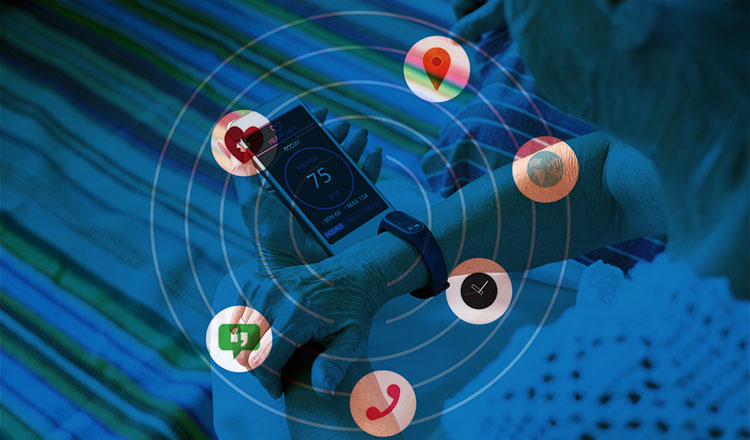In today’s market, wearable technology tends to be more sophisticated, because it provides sensory and scanning features such as biofeedback and tracking of physical function, which is not seen in mobiles and laptops. The wearable technology market grew 29% in 2016, with 101.9 million units sold, according to IDC worldwide quarterly wearable devices tracker. The organization projects that the wearable market will reach more than 213 billion units by 2020.
IoT and wearable technology are set to transform every industry, of which healthcare is not left behind. Consequently, we see a rapid growth in the IoHT (Internet of Health Things) devices being utilized by healthcare organizations and professionals.
The Internet of Health Things (IoHT) is a collection of medical devices as well as applications that connect to healthcare IT system through an online computer network. These medical devices allow machine-to-machine (M2M) communication over the internet, and further, link to a cloud platform through which data gets captured, stored and analysed.
Why Wearables are Important in Internet of Health Things (IoHT)
Wearables come in many forms such as smart wristbands, watches, shirts, shoes, shorts, caps, headbands, eyeglasses, belts and necklaces, etc. These devices are compact, portable, and power efficient embedded systems, which are designed to generate quick and intelligent data. Most of the wearable devices contain sensors that gather raw data, which are then fed to a database or software application for analysis. This analysis typically triggers a response. For example, an alert to a physician to contact a patient who is suffering from abnormal symptoms can help him communicate with the patient and give timely advice.
In today’s world, the working class people, especially those who spend most time of the day juggling between various tasks, tend to ignore their health and fitness. Going for doctor’s prescribed tests consumes a lot of time. Moreover, there are delays in the reports, and chances of human errors. Hence, many people are seeking an alternative, such as a device that can be worn or mated with human skin to continuously and closely monitor an individual’s activities in terms of health and fitness in real time. In addition, these wearable items can provide timely awareness on various health parameters to the user as well as his physician.
Apart from these, there are many ways in which wearables are helping in the healthcare services as mentioned below:
1. Real-time Health Monitoring using Wearable Sensors

In today’s era, the rapid growth in technology has remarkably enhanced the scope of remote health monitoring, where real-time health monitoring system plays a vital role. These systems are developed considering the cost, ease of application, accuracy, and data security. It facilitates a two-way communication between the doctor and the patient. The main purpose of these health monitoring systems is to provide latest healthcare information. These RMS systems have two interfaces, one for patients and another for the doctor. The patient interface is comprised of wearable sensors which extract medical information of the patients and transmit to an Android-based listening port via Bluetooth low energy. The listening port transfers this information to the web server, which processes data to show reports on the doctor’s interface.
Let us understand the working of these real-time monitoring systems with an example of remote cardiac patients.
A remote monitoring with a diagnostic framework detects underlying heart conditions in real-time, which helps in avoiding potential heart diseases and helps patients recover from cardiac diseases. The system is compatible with various wearable sensors to extract medical information, which also helps in finding out multiple parameters such as heart rate, blood pressure, and body and skin temperature at the same time. These cardiac parameters also help in early detection of diseases such as arrhythmia, hypotension, hypertension, and hyperthermia through the alarming system based on upper and lower threshold values.
2. Fitness Wearables

Smart wearable devices are helping people in making this resolution a success, with some striving for personal satisfaction while some for competitiveness.
Fitness wearables such as Fitness trackers help in monitoring or tracking fitness-related metrics such as distance walked or run, calorie consumption, and in some cases heartbeat and quality of sleep. These trackers are devices or applications such as Smart Watches or Smart Bands that are synced wirelessly to a computer or Smart Phone for real-time tracking of health-related data. Such trackers are mainly used by sports or fitness freaks, or overweight people, which help them monitor physical activities or a guided weight loss program.
3. Chronic Diseases Prevention using Wearables

Chronic disease management is not just a challenge, but also a burden to the healthcare system. Nearly 85% of our healthcare dollars are spent on caring for chronic diseases, which are the most common, costly, and preventable of all health problems. These include diabetes, asthma, heart disease, and chronic pain from various causes, which require investment in monitoring, compliance, and behavioral changes.
Asthma is affecting 25 million people in the U.S, according to the Centre for Disease Control (CDC). According to this report, an estimated 44,000 Asthma attacks occur every single year in the U.S. The main reason for Asthma is the lack of awareness of symptoms that could indicate risks of attacks.
For example: ADAMM (Automated Device for Asthma Monitoring and Management), developed by Health Care Originals, is an intelligent Asthma monitoring wearable system that is waterproof, soft, and flexible. It can communicate with a smartphone app and web portal using Wi-Fi, Bluetooth, and cellular connections. The device is attached to the upper torso (trunk of the upper body) using skin-safe adhesive, which tracks forerunner symptoms of asthmatic attacks, including respiration pattern, cough rate, heartbeat, and body temperature.
4. Wearables in Elderly Care

The rapid growth of aged population has caused an immense increase in the demand for healthcare services. Generally, the elder persons are more prone to health problems compared to other groups. The elderly currently represent about 14.5 percent of the U.S. population, and by 2030 there will be about 74 million older individuals. According to a research, Older Americans 2016: Key Indicators of Well-Being, older adults are living longer and facing new economic, healthcare, and residential living challenges. Twenty-two percent have at least one limitation in vision, hearing, mobility, communication, and cognition, or self-care, requiring attention.
There are different smart wearables that can help in elderly care, for example, Smart Glasses; help seniors to manage their failing eyesight. Smart Glasses refers to a device that brings a computer screen/display in front of a person’s eyes in order to represent data from the background information system. More importantly, the user can see the environment without interference when he/she is not looking for information provided by the smart glasses.
It can also be accompanied with “Augmented reality”, which augments the existing real world with additional information provided by the information system. There is a certain difference when comparing to display techniques for watching moving images/video. Some advanced smart glass systems can automatically provide information about a scenery and even provide facial recognition of a person coming towards them, which helps prevent theft or thieves when no one is around the elderly person.
Conclusion
Overall, healthcare is growing towards smart wearable technologies with which disease detection, prevention, and precautions become easier. From remote health monitoring to the prevention of chronic diseases, every healthcare paradigm has consortiums for IoT and wearable technologies. Thus, smart wearables are enabling a highly reliable, available, scalable, and resilient system for a healthy ecosystem.
eInfochips has hands-on engineering experience in monitoring, diagnostics, analysis, imaging, wearable health and telemedicine solutions for medical applications. Our team has led medical products from concept and architecture definition to prototyping, field trials, certification and sustenance engineering. We have also provided mobile-enabled solutions for medical devices and clinical software, integrating them securely with the cloud infrastructure for remote diagnosis and ease of access.













